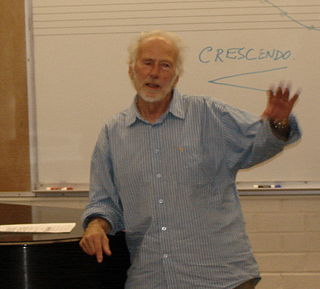Related Research Articles

Raymond Murray Schafer was a Canadian composer, writer, music educator, and environmentalist perhaps best known for his World Soundscape Project, concern for acoustic ecology, and his book The Tuning of the World (1977). He was the first recipient of the Jules Léger Prize in 1978.

Nikolai Sergeevich Korndorf was a Russian and Canadian composer and conductor. He was prolific both in Moscow, Russia, and in Vancouver, British Columbia, Canada.

Claude Vivier was a Canadian composer, pianist, poet and ethnomusicologist of Québécois origin. After studying with Karlheinz Stockhausen in Cologne, Vivier became an innovative member of the "German Feedback" movement, a subset of what is now known as spectral music. He was also among the first composers in either Europe or the Americas to integrate elements of Balinese music and gamelan in his compositions, alongside Lou Harrison, John Cage and fellow Québécois Colin McPhee.
Bob Gilmore was a musicologist, educator and keyboard player.
Síppal, dobbal, nádihegedűvel (2000) is a song cycle in seven movements by the composer György Ligeti based on poetry by Sándor Weöres. The work is scored for mezzo-soprano and an unusual ensemble of percussion and wind instruments. The lyrics are whimsical and often nonsensical, sometimes combining random Hungarian words or parts of words into a nonsense language.
Lawrence Ball is an English musician and composer who lives in North London. He produces multi-media compositions, performs in concert, and also works as a private tutor in mathematics, music theory and physics.
La Transfiguration de Notre Seigneur Jésus-Christ is a work written between 1965 and 1969 by Olivier Messiaen. It is based on the account found in the synoptic gospels of Jesus' transfiguration. The writing is on a very large scale; the work requires around 200 performers. The forces required include a mixed choir, seven instrumental soloists and a large orchestra; only being surpassed by his opera Saint François d'Assise.
"Shiraz" is a virtuosic piano piece by Claude Vivier, written in 1977. It is named after the eponymous Iranian city, and contains a flurry of interlocking rhythmic combinations and pulses at great speed. Vivier was inspired to write the piece after listening to blind singers perform in the city's market square. He wrote in the piece's program notes how he found Shiraz to be, "a pearl of a city, a diamond vigorously cut."
Lonely Child is a piece for soprano and orchestra by Claude Vivier, written in 1980. It is arguably his most well-known piece, and is considered a hallmark composition in the genre of spectral music.

Orion is a 1979 orchestral suite by Claude Vivier, inspired by the constellation of the same name. It is among the first compositions in Vivier's catalogue to delve into a unique compositional style he referred to as the jeux de couleurs. A typical performance lasts around thirteen minutes.
Kopernikus is a 1979 opera in two acts by Canadian composer Claude Vivier, inspired by the astronomer of the same name. It is the only opera of three that Vivier completed prior to his death in 1983. A typical performance lasts around seventy minutes.
Pianoforte is a 1975 piano piece by Canadian composer Claude Vivier.
Canadian composer Claude Vivier's Pièces are a series of four chamber compositions for two performers, with varying instrumentation. They were all written in the year of 1975.

Zipangu is a 1980 work for string orchestra by Canadian composer Claude Vivier. Inspired by traditional kabuki theatre, it is considered by many to be the composer's most aggressive and "unforgiving" piece, as it features a plethora of extended techniques for strings and denser harmonic content atop a complex melody, similar to the string compositions of Krzysztof Penderecki. A typical performance lasts around sixteen minutes.
Bouchara is a 1981 work for mixed chamber ensemble by Canadian composer Claude Vivier. It was originally intended to serve as an interlude for his unfinished opera Rêves d'un Marco Polo (1983-), but was published independently of the opera after weeks of deliberation. A typical performance lasts around twelve minutes.
Canadian composer Claude Vivier (1948–83) wrote four extant pieces for the tape recorder, in the musique concrète tradition established by French composer Pierre Schaeffer in the 1940s. Multiple other pieces from his career include the tape machine being used as an additional instrument to various ensembles. The majority of these compositions were a result of Vivier studying with Gottfried Michael Koenig at the Institute for Sonology in Utrecht.
Cinq chansons pour percussion is a 1980 work for solo percussionist by Canadian composer Claude Vivier. It is an example of an extended American gamelan, featuring a very large array of percussion instruments that include gongs and bells from Chinese, Japanese, Indonesian and Thai origin.
Glaubst du an die Unsterblichkeit der Seele? is an unfinished 1983 chamber piece by Canadian composer Claude Vivier. It is one of his most famous compositions, as the libretto is claimed by some to have predicted the composer's own murder in March of the same year. The piece was left incomplete and unrevised with just three short movements, a typical performance lasting around eight minutes.
Et je reverrai cette ville étrange is a 1981 work for chamber ensemble by Canadian composer Claude Vivier. It is an extreme manifestation of monody, with all instruments playing in unison with a continuous melodic line throughout the piece. Musicologists generally view this piece as one of the apexes of his timbral concept, jeux de couleurs.
References
Citations
- 1 2 Gilmore (2014), p. 401.
- ↑ Lankenau, Chan & Gewirtz (2012), p. 36.
Sources
- Gilmore, Bob (2014). Claude Vivier: A Composer's Life. University of Rochester Press. ISBN 978-1-58046-841-1.
- Lankenau, Steven; Chan, Trudy; Gewirtz, Eric (2012). Vivier Works: Claude Vivier (PDF). Boosey and Hawkes.